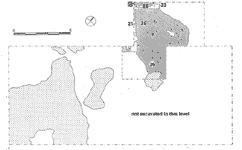EXCAVATIONS AT COSA (1991-1997), PART 2: THE STRATIGRAPHY
Part 2: The Stratigraphy
> The Arx and the area to the west (IV G)
> Arx I
Arx I(Elizabeth Fentress, 1990)
ObjectivesThe trench was excavated to the west of the main gate of the Arx, in an area where no previous excavation had taken place. The aim was to establish the post-republican stratigraphy of the Arx, in an area which was certainly undisturbed by previous excavation.DimensionsThe trench measured 14 x 6m., with an extension towards the northwest of 3 x 4.5m. Excavation was completed as far as republican levels only in this latter part.StratigraphyThe earliest activity on the site was the leveling of the Arx. This involved the cutting of a large amount of stone in the upper area and its redeposition down slope, along the line of the northern terrace wall (31). Above this a rough surface of earth and small stones accumuÇlated, (30). Over this a second surface, 26, was apparently associated with the construction of a building on the northwest side of the trench. Only five walls of this structure were visible, and these were largely robbed-out. Two walls, 22 and 28, formed a corner around a floor in hydraulic cement with quarter-round mouldings: there is some evidence that they were built of mortared stones (fig. 46). Two other walls formed a second corner, but were even less clear as their robber-trenches lay almost entirely under the section. There seems to have been a door between the two rooms formed by these walls, but we can say very little about the building that they belonged to, except that it fronted on the street. Here a single course of large blocks 18 meters long seems to indicate that the building was almost exactly the width of the large houses around the forum. We may tentatively associate it with these, although our evidence for its dating is limited to the spread of late-first century B.C. rubble which covers it. This consists of a thick layer (18) containing large quantities of pottery - principally amphorae, with some fine wares Ò that was deposited outside these walls, although there is no evidence that the building was in use during the deposition. This layer may represent deliberate leveling, or simply a midden deposit, although it was not particularly rich in bones or other debris. Spreads of plaster (17) over its northern portion may suggest some attempt at the creation of a deliberate surface: they are perhaps too distant to be related to the repairs to the Capitoline temple, which took place in the Augustan period.The deposit was then cut by the robber trenches (20/21) which removed most traces of the building. Although no finds were associated with the robber trenches, it is likely that the robbing of the building and the leveling of the area took place during the Augustan period, when the temples of the Arx were all refurbished. A single new surface (5 and 6-9) was deposited over the robber trenches and the Augustan leveling. This was formed of compacted dark earth, fairly irregular, with patches of bedrock emerging at intervals, particularly at the southern end of the trench. A number of small stake holes were identified in this surface, but they formed no convincing pattern, and are likely to represent root activity. The dating of this surface depends on a 6th-c. fibula (part IV, p. 242) and the presence of four sherds of 6th-c. coarsewares, similar to those found in the construction trench of the 6th-c. castrum wall. A final surface (3), no more than 4cm. thick, was compacted over the top of this, but its association with a fine, black, ashy topsoil suggests that it is related to pre-modern charcoal burning. |
